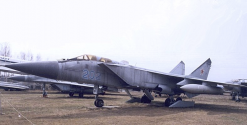Why buy 14 large (240 ton) refueling aircraft when you don't have even 170 combat jets?
The number of refueling aircraft is very reasonable. Refueling aircraft are the most fundamental force multiplier in aerial operations because they determine battlespace presence. Ground and naval forces may have limited mobility when short on fuel but they are already taking control of position by their mere presence and in many instances can sufficiently defend that position. That is not true of aircraft.
Aircraft are present in battlespace only when they are
at altitude. On the ground they count as ships in port or troops in barracks - they are force in being that can join the battle but isn't there yet. To stay in the air aircraft have to expend fuel and that limits not only
how far they can fly but for
how long they can fly.
For example an F-16 without spare tanks can fly for approx 1,5-2hours. To remain on station for 4 to 8 hours two or more refuelings are necessary. If you want to refuel on the ground the not only do you make your aircraft vulnerable but also waste time and energy because significant amount of fuel is expended by gaining altitude at high speed to reduce time on the ground.
So the fewer aircraft you have the more an aerial refueler can expand the total time at altitude per flight.
24 aircraft with refueling can stay in the air for as long as 72 or 96 aircraft without refueling. Also since takeoff and landing are straining the machine it does to a degree influence availability of aircraft due to breakdowns.
The notion that refueling aircraft are not essential is mostly product of Russian propaganda. Russians don't really understand either aerial or naval operations and in general struggle with any expeditionary mindset - which is plainly clear in Ukraine - so they program their air force and navy as "air army" and "sea army" and then make use of propaganda to justify those decisions. In public debate on the internet where majority of voices are angry keyboard warriors that mindset simply overpowers the correct and rational approach that was developed through actual practice of aerial and naval logistics.
When you look at Ukraine one of the biggest problems VKS is dealing with is the lack of aerial refueling aircraft to keep CAPs in the air for longer than their usual ~3-4hr maximum duration. Su-35s and MiG-31s have to constantly take off and land. Compared to how USAF resolved CAP in Desert Storm by maintaining long duration patrols of 2-3 pairs of F-15s at altitude at any given time - due to the extensive use of refueling (and spare tanks which Flankers can't use!) - this is extremely inefficient.
Britain also benefits from having larger number of refuelers for any Falklands scenario. The bombing run from the war was an unbelievably elaborate dance of buddy-buddy refueling. If there's any crisis in that region - or anywhere else at significant distance - those additional 2-3 refuelers available (which requires approx. 6 aircraft for rotation) will be of utmost value, because they will not reduce the baseline availability for other RAF operations.
So RAF is essentially buying 2-3x the usual number of refuelers for local operations. For example Italian Air Force has 4 B767 refuelers. On the other than French Air Force has similarly 12 A330 MRTTs due to similar requirements and commitments.
War is not about having a large number of expensive gadgets. It's about being to use them to their full potential with maximum efficiency.
And if you are buying such aircraft, why you buy them in a configuration that they can't refuel your special mission aircraft?
Most likely booms are not a requirement for RAF.
F-35B use probe-and-drogue because they don't have the fuel tank that A variant has because that space it taken up by the VTOL fan.
Typhoons also use probe-and-drogue.
Nobody needs E-7s, P-8s or RC-135 to fly for longer than the usual flight durations because the crew can't handle it. Those crews have extremely high task load and can only work efficiently for a specific period of time.
C-17s is a heavy transport plane and has already long range with large payload so a refueler that could meaningfully assist a C-17 would have to first
carry the fuel to the point of refueling which makes the whole exercise pointless.
A400 uses probe-and-drogue.

